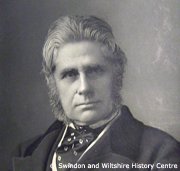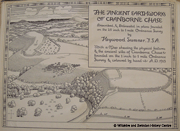The Legacy of Pitt Rivers
 Any history of archaeological investigation in the AONB needs to place considerable emphasis on the work and legacy of General Augustus Lane-Fox Pitt Rivers (1827-1900) who after inheriting the estate at Rushmore undertook slow and extensive excavations on sites within the estate and surrounding area. Pitt Rivers was interested in understanding the history of each site, carefully recording stratigraphy and the position of finds. Pitt Rivers also stressed the importance of publishing a complete record of his work, producing beautifully illustrated reports. Pitt Rivers is seen by many as a central figure in the development of archaeology, and even as the father of scientific archaeology. His position as the first Inspector of Ancient Monuments following the passing of the Ancient Monuments act of 1882 is also highly significant. But as Bowden points out in his comprehensive biography of the general:
Any history of archaeological investigation in the AONB needs to place considerable emphasis on the work and legacy of General Augustus Lane-Fox Pitt Rivers (1827-1900) who after inheriting the estate at Rushmore undertook slow and extensive excavations on sites within the estate and surrounding area. Pitt Rivers was interested in understanding the history of each site, carefully recording stratigraphy and the position of finds. Pitt Rivers also stressed the importance of publishing a complete record of his work, producing beautifully illustrated reports. Pitt Rivers is seen by many as a central figure in the development of archaeology, and even as the father of scientific archaeology. His position as the first Inspector of Ancient Monuments following the passing of the Ancient Monuments act of 1882 is also highly significant. But as Bowden points out in his comprehensive biography of the general:
"However, if for no other reason, the General has had a significant influence on British Archaeology as the excavator of over forty sites including such classics as Wor Barrow, South Lodge Camp and Woodcutts, all of which have been sources of reference and reinterpretation for later researchers". (1991: 1)
Pitt Rivers also has a central role in the development of anthropology and ethnography, as represented by the Pitt Rivers Museum in Oxford. He was also an early exponent of the role of archaeology in public education as demonstrated by his pleasure grounds at the Larmer Tree and museum at Farnham. The museum was finally closed in 1966 and the archaeological collections transferred to Salisbury Museum in 1975.

Following Pitt Rivers in death there was a general decline in standards in archaeological excavation and fieldwork. A major exception to this however was Heywood Sumner, a devoted follower of the general who also focused his activities on the Cranborne Chase.
Other investigations by amateur archaeologists during the first half of the 19th century were variable in quality. These range from excavations of the Roman Temple on Whitesheet Hill by Nan Kevill in 1925, 1926 which recorded no information of stratigraphy, features or the locations of the spectacular finds to much more systematic excavations undertaken by R C Clay of the Iron Age settlements of the Cranborne Chase during the same period.
Download a short introduction to the history of archaeological discovery in the AONB (PDF 851 KB).
This document forms part of the wider AONB Historic Environment Action Plans.
